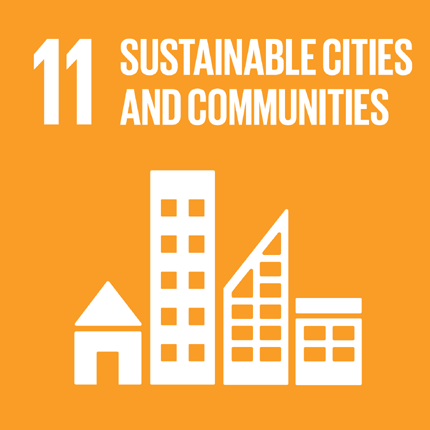sdg11
SUSTAINABLE DEVELOPMENT GOAL 11
Make cities and human settlements inclusive, safe, resilient and sustainable
Progress of goal 11
- More than half the world’s population lives in cities. By 2030, it is projected that 6 out of 10 people will be urban dwellers. Despite numerous planning challenges, well-managed cities and other human settlements can be incubators for innovation and ingenuity and key drivers of sustainable development.
- However, as more people migrate to cities in search of a better life and urban populations grow, housing issues intensify. Already in 2014, 30 per cent of the urban population lived in slum-like conditions; in sub-Saharan Africa, the proportion was 55 per cent, the highest of any region. Globally, more than 880 million people were living in slums in 2014. This estimate does not include people in inadequate or unaffordable housing (defined as costing more than 30 per cent of total monthly household income).
- As population growth outpaces available land, cities expand far beyond their formal administrative boundaries. This urban sprawl can be seen in many cities around the world, and not only in developing regions. From 2000 to 2015, the ratio of the land consumption rate to the population growth rate in Eastern Asia and the Oceania was the highest in the world, with developed regions second. Other regions, such as South-Eastern Asia and Latin America and the Caribbean, showed a decrease in that indicator over the same time period. Unfortunately, a low value for this ratio is not necessarily an indication that urban dwellers are faring well, as this can indicate a prevalence of overcrowded slums. Unplanned urban sprawl undermines other determinants of sustainable development. For example, for every 10 per cent increase in sprawl, there is a 5.7 per cent increase in per capita carbon dioxide emissions and a 9.6 per cent increase in per capita hazardous pollution. This illustrates the important interlinkages across the goals and targets.
- Likewise, managing solid waste is often problematic in densely populated areas. In fact, in many developing regions, less than half of solid waste is safely disposed of. As per capita waste generation continues to rise, the collection and safe disposal of solid waste will continue to require serious attention.
- Urban air pollution also challenged cities around the world, causing illness and millions of premature deaths annually. In 2014, around half the global urban population was exposed to air pollution levels at least 2.5 times higher than maximum standards set by the World Health Organization.
- The quest for sustainable and coordinated urban development starts with national policies and regional development plans. As of 2015, 142 countries had a national urban policy in place or under development. Those countries are home to 75 per cent of the world’s urban population.
Source: United Nations, Department of Economic and Social Affairs, SUSTAINABLE DEVELOPMENT KNOWLEDGE PLATFORM
The National Indicators for Sustainable Development Goal 11 are:
- Overcrowding rate by poverty status (%)
- Population living in households considering that they suffer from noise, by poverty status
- People killed in road accidents (per 100 000 persons)
- Years of life lost due to PM 2.5 exposure (Particulates < 2,5µm)
- Recycling rate of municipal waste (%)
All available data in .xls file:
- Sustainable cities and communities
Last Updated: 9/5/2025
EU SDG indicator set
To measure SDG achievement in an EU context, an EU SDG indicator set was developed under the leadership of Eurostat. The purpose of this set, which is structured along the 17 global Sustainable Development Goals, is to monitor progress towards the SDGs at the European level.
- For the complete set of indicators available in the Eurostat database, click here.
- To compare Greece’s progress on specific indicators for each Sustainable Development Goal, click here [data visualisation].

